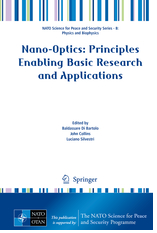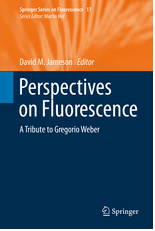Difference between revisions of "Book Reviews Editorials Point of View"
| Line 4: | Line 4: | ||
# '''Nano-Optics: Principles Enabling Basic Research and Applications''' by Di Bartolo, Baldassare, Collins, John, Silvestri, Luciano (Eds.), Springer, 2017.[[File:Vol.1.png|right|250px]] | # '''Nano-Optics: Principles Enabling Basic Research and Applications''' by Di Bartolo, Baldassare, Collins, John, Silvestri, Luciano (Eds.), Springer, 2017.[[File:Vol.1.png|right|250px]] | ||
This book provides a comprehensive overview of nano-optics, including basic theory, experiment and applications, particularly in nanofabrication and optical characterization. The contributions clearly demonstrate how advances in nano-optics and photonics have stimulated progress in nanoscience and -fabrication, and vice versa. Their expert authors address topics such as three-dimensional optical lithography and microscopy beyond the Abbe diffraction limit, optical diagnostics and sensing, optical data- and telecommunications, energy-efficient lighting, and efficient solar energy conversion. Nano-optics emerges as a key enabling technology of the 21st century. This work will appeal to a wide readership, from physics through chemistry, to biology and engineering. The contributions that appear in this volume were presented at a NATO Advanced Study Institute held in Erice, 4-19 July, 2015. | This book provides a comprehensive overview of nano-optics, including basic theory, experiment and applications, particularly in nanofabrication and optical characterization. The contributions clearly demonstrate how advances in nano-optics and photonics have stimulated progress in nanoscience and -fabrication, and vice versa. Their expert authors address topics such as three-dimensional optical lithography and microscopy beyond the Abbe diffraction limit, optical diagnostics and sensing, optical data- and telecommunications, energy-efficient lighting, and efficient solar energy conversion. Nano-optics emerges as a key enabling technology of the 21st century. This work will appeal to a wide readership, from physics through chemistry, to biology and engineering. The contributions that appear in this volume were presented at a NATO Advanced Study Institute held in Erice, 4-19 July, 2015. | ||
| − | # Perspectives on Fluorescence, Jameson, David M. (Ed.), Springer 2016. | + | # Perspectives on Fluorescence, Jameson, David M. (Ed.), Springer 2016.[[File:Vol.2.png|right|250px]] |
Gregorio Weber is widely acknowledged as the person responsible for the advent of modern fluorescence spectroscopy. Since 2016 is the 100th anniversary of Gregorio Weber’s birth, this special volume has been prepared to honor his life and achievements. It offers contributions from outstanding researchers in the fluorescence field, describing their perspectives on modern fluorescence and its highly diverse applications, ranging from the photophysics of tryptophan and proteins, membrane studies, fluorescence microscopy on live cells, novel software approaches and instrumentation. Many of the authors knew Gregorio Weber personally and have shared their impressions of the man and his contributions. This volume appeals not only to aficionados of fluorescence spectroscopy and its applications in biology, chemistry and physics, but also to those with a general interest in the historical development of an important scientific field. | Gregorio Weber is widely acknowledged as the person responsible for the advent of modern fluorescence spectroscopy. Since 2016 is the 100th anniversary of Gregorio Weber’s birth, this special volume has been prepared to honor his life and achievements. It offers contributions from outstanding researchers in the fluorescence field, describing their perspectives on modern fluorescence and its highly diverse applications, ranging from the photophysics of tryptophan and proteins, membrane studies, fluorescence microscopy on live cells, novel software approaches and instrumentation. Many of the authors knew Gregorio Weber personally and have shared their impressions of the man and his contributions. This volume appeals not only to aficionados of fluorescence spectroscopy and its applications in biology, chemistry and physics, but also to those with a general interest in the historical development of an important scientific field. | ||
Revision as of 12:49, 9 February 2017
- Fluorescent Nanodiamonds by Chang, Huan-Cheng, Hsiao, Wesley Wei-Wen, Su, Meng-Chih, Springer 2018
This book thoroughly summarizes all aspects of fluorescent nanodiamonds, including fundamental properties, synthesis, mechanisms, functionalization and applications. A special focus is placed on the current and potential applications of fluorescent nanodiamonds on bioimaging, quantum sensing, proteomics and drug delivery. Issues associated with the applications are also addressed. The audience of this book includes academic researchers, industry professionals, as well as instructors and students working in the fields of nanotechnology, biomedical engineering and others.
- Nano-Optics: Principles Enabling Basic Research and Applications by Di Bartolo, Baldassare, Collins, John, Silvestri, Luciano (Eds.), Springer, 2017.
This book provides a comprehensive overview of nano-optics, including basic theory, experiment and applications, particularly in nanofabrication and optical characterization. The contributions clearly demonstrate how advances in nano-optics and photonics have stimulated progress in nanoscience and -fabrication, and vice versa. Their expert authors address topics such as three-dimensional optical lithography and microscopy beyond the Abbe diffraction limit, optical diagnostics and sensing, optical data- and telecommunications, energy-efficient lighting, and efficient solar energy conversion. Nano-optics emerges as a key enabling technology of the 21st century. This work will appeal to a wide readership, from physics through chemistry, to biology and engineering. The contributions that appear in this volume were presented at a NATO Advanced Study Institute held in Erice, 4-19 July, 2015.
- Perspectives on Fluorescence, Jameson, David M. (Ed.), Springer 2016.
Gregorio Weber is widely acknowledged as the person responsible for the advent of modern fluorescence spectroscopy. Since 2016 is the 100th anniversary of Gregorio Weber’s birth, this special volume has been prepared to honor his life and achievements. It offers contributions from outstanding researchers in the fluorescence field, describing their perspectives on modern fluorescence and its highly diverse applications, ranging from the photophysics of tryptophan and proteins, membrane studies, fluorescence microscopy on live cells, novel software approaches and instrumentation. Many of the authors knew Gregorio Weber personally and have shared their impressions of the man and his contributions. This volume appeals not only to aficionados of fluorescence spectroscopy and its applications in biology, chemistry and physics, but also to those with a general interest in the historical development of an important scientific field.

